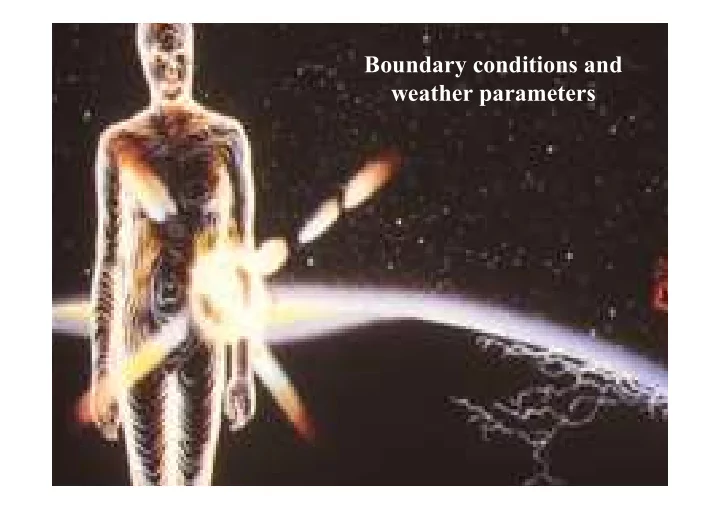

Boundary conditions and weather parameters
Required weather parameters Dry bulb temperature (C) Wet bulb temperature (C) Wind speed (m/s) Wind direction (° from North) Relative humidity (%) Atmospheric pressure (bar) Net longwave radiation (W/m 2 ) Precipitation (mm) Global horizontal (or direct normal) solar radiation (W/m 2 ) Diffuse horizontal solar radiation (W/m 2 ) and, where solar radiation data is not available: Cloud cover and type (%, -) Sunshine hours (hr) Other data: ground temperature (C), snow cover (m), solar illuminance (lux), precipitation (m).
UK solar radiation stations Station Latitude Longitude Elevation ( m ) Element measured Lerwick 60° 08’ N 01° 11’ W 82 G, D, L, B, SS Eskdalemuir 55° 19’ N 03° 12’ W 242 G, D, L, B, SS Aldergrove 54° 39’ N 06° 13’ W 68 G, D, L, B, SS Aberporth 52° 08’ N 04° 34’ W 133 G, D, SS Cardington 52° 06’ N 00° 25’ W 29 G, D, SS London 51° 31’ N 00° 07’ W 77 G, D, L, SS Kew 51° 28’ N 00° 19’ W 5 G, D, L, B, SS, I, F Bracknell 51° 23’ N 00° 47’ W 73 G, D, L, SS, I, F, N, S, E, W Jersey 49° 13’ N 02° 12’ W 83 G, D, L, B, SS Aberdeen 57° 10’ N 02° 05’ W 35 G Dunstaffnage 56° 28’ N 05° 26’ W 3 G Dundee 56° 27’ N 03° 04’ W 30 G, B Hurley 51° 32’ N 00° 49’ W 43 G G = global horizontal solar radiation D = diffuse horizontal solar radiation I = direct normal solar radiation SS = sunshine hours B = radiation balance L = total horizontal illumination F = diffuse horizontal illumination N/S/E/W are total solar radiation on vertical surfaces facing the cardinal points
Solar irradiation calculation In solar irradiance calculations some quantities are normally available as input and some are normally calculated. • Inputs (as measured): diffuse horizontal irradiance; global horizontal (or direct normal) irradiance. • Calculated (for an arbitrarily inclined surface): direct irradiance; sky diffuse irradiance; ground reflected irradiance. Other parameters may need to be determined by calculation, e.g. local surface pressure, future climate.
Weather boundary conditions Two conditions require to be met: Portions of the collection should correspond to the different levels of severity under which the energy system will operate, e.g. extreme and typical conditions in the winter, summer and transition seasons. http://www.comfortfutures.com/urban-heat-island-effect/ The collection overall should support an assessment of cost-in-use (‘typical’ years often used based on statistical comparisons between individual monthly means and long-term monthly means. Micro-climate effects may need to be considered.
Example weather collections UK Met Office/CIBSE - Test Reference Years (TRY) for 14 UK locations European Test Reference Years. ASHRAE - International Weather for Energy Calculations (IWEC) for 227 locations outside the USA and Canada ASHRAE WYEC2 for USA locations. Canadian Weather for Energy Calculation (CWEC) National Climatic Data Center - Typical Meteorological Year (TMY) for 229 locations in the USA plus 5 locations in Cuba, Marshall Islands, Palau and Puerto Rico National Renewable Energy Laboratory - TMY 2 for 237 locations in the USA plus Guam and Puerto Rico National Renewable Energy Laboratory - TMY 3 for 1020 locations in the USA including Guam, Puerto Rico and US Virgin Islands Meteonorm (http://www.meteonorm.com) - catalogue of meteorological data for any desired location in the world plus data for other locations See http://apps1.eere.energy.gov/buildings/energyplus/weatherdata_sources.cfm for further details.
Energy system influence Typical years appropriate for estimating long-term energy performance. Multi-year simulations with observed data required to predict peak energy consumption and for system reliability studies. Whether a weather parameter has a 1st or 2nd order effect on an energy system will depend on the principal energy mechanisms involved. Some example 1st order effects: photovoltaics – solar irradiance; insulation – temperature; light shelf – illuminance; infiltration – wind velocity; roof heat loss – longwave radiation; air source heat pump – temperature. In some cases it is necessary to take account of micro-climate effects, e.g. shading, wind sheltering and heat island effects of the urban environment..
Recommend
More recommend